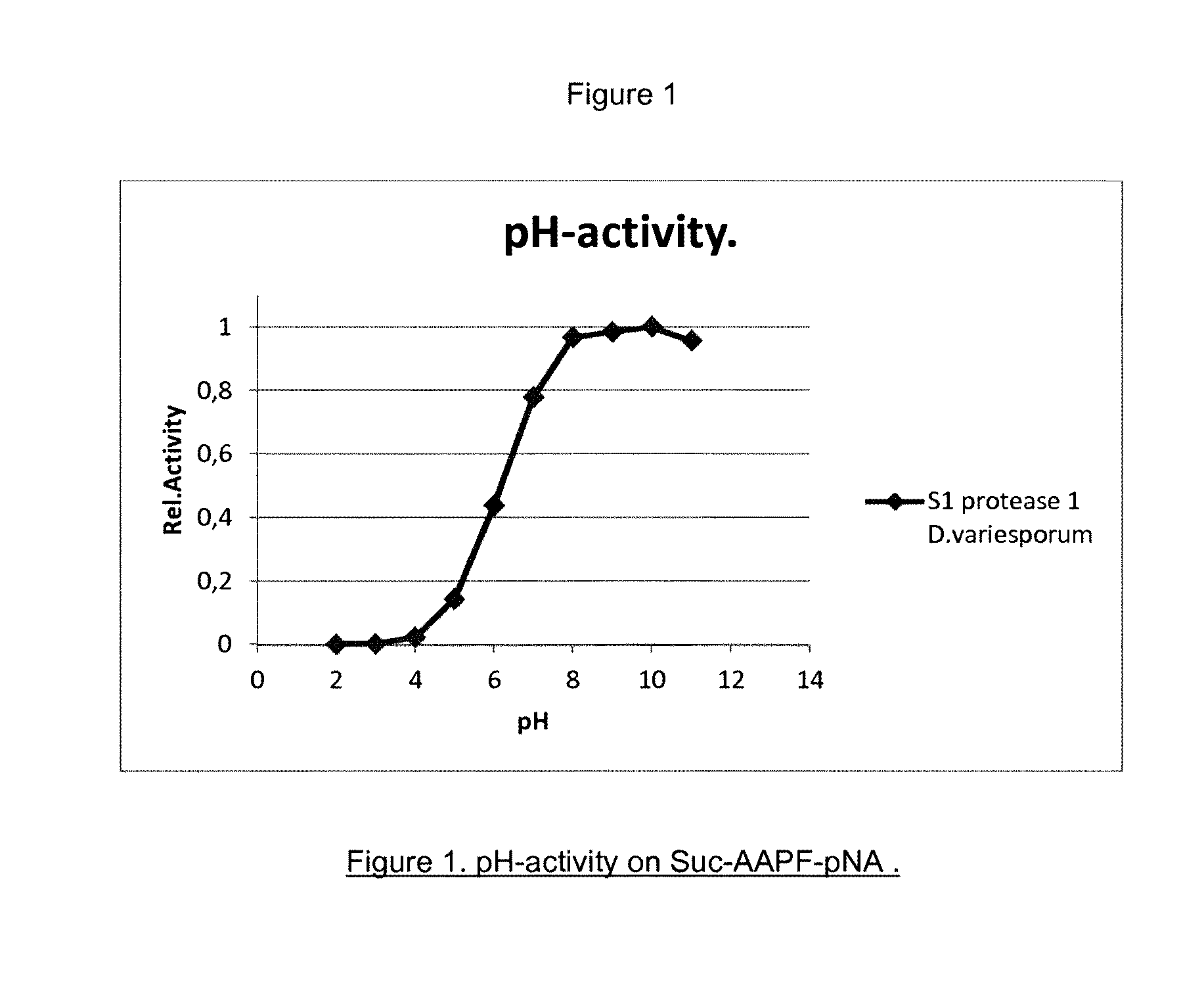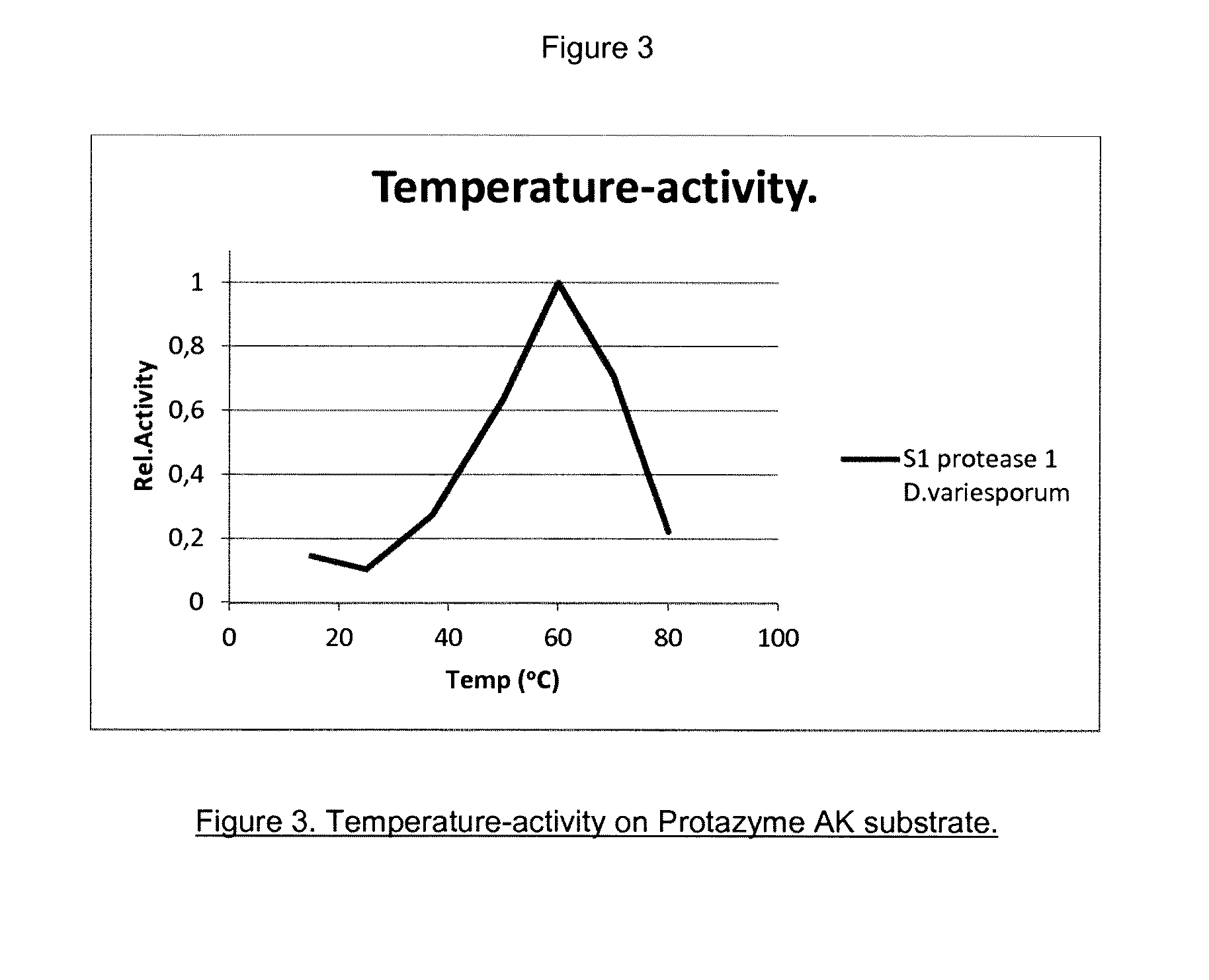Polypeptides Having Protease Activity and Polynucleotides Encoding Same
a technology of protease activity and polynucleotide, which is applied in the field of isolated polypeptides having protease activity and isolated nucleic acid sequences encoding the proteases, can solve the problems of global tendency to lowering wash time, ph and temperature, and decreasing the amount of detergent components, which may influence the environment negatively
- Summary
- Abstract
- Description
- Claims
- Application Information
AI Technical Summary
Benefits of technology
Problems solved by technology
Method used
Image
Examples
embodiments
[0111]In certain embodiments of the invention, the protease of the invention exhibits beneficial thermal properties such as thermostability, steam stability, pH properties, such as acid stability, etc.
Acidity / Alkalinity Properties
[0112]In certain embodiments of the invention, the protease of the invention exhibits beneficial properties in respect of pH, such as acid stability etc. Stability of the protease at a low pH is beneficial since the protease can have activity in the intestine after passing through the stomach. Stability of the protease at a high pH is beneficial for cleaning and washing since detergent compositions often have an alkaline pH. In one embodiment of the invention, the protease retains >90% activity after 2 hours at pH 4 as determined using the method described in Example 4. In another embodiment of the invention, the protease retains >90% activity after 2 hours at pH 10 as determined using the method described in Example 4.
[0113]The present invention provides p...
example 1
DNA-Preparation and Sequencing of the Dactylosporangium variesporum Genome
[0414]Chromosomal DNA of Dactylosporangium variesporum (reclassified in 2011 as Saccharothrix variisporea) was isolated by “QIAamp DNA Blood Mini Kit” (Qiagen, Hilden, Germany). 5 ug of chromosomal DNA was sent for genome sequencing at FASTERIS SA, Switzerland. The genome was sequenced by Illumina Sequencing. The genome sequence was analysed for secreted S1 proteases and one S1 protease (SEQ ID: 1 / SEQ ID:2) was selected for expression.
example 2
Expression of the S1 Protease 1 from Dactylosporangium variesporum
[0415]A linear integration vector-system was used for the expression cloning of the SIA protease 1 from Dactylosporangium variesporum (SEQ ID NO: 2). The linear integration construct was a PCR fusion product made by fusion of the gene between two Bacillus subtilis homologous chromosomal regions along with a strong promoter and a chloramphenicol resistance marker. The fusion was made by SOE PCR (Horton, R. M., Hunt, H. D., Ho, S. N., Pullen, J. K. and Pease, L. R. (1989) Engineering hybrid genes without the use of restriction enzymes, gene splicing by overlap extension Gene 77: 61-68). The SOE PCR method is also described in patent application WO 2003095658. The gene was expressed under the control of a triple promoter system (as described in WO 99 / 43835), consisting of the promoters from Bacillus licheniformis alpha-amylase gene (amyL), Bacillus amyloliquefaciens alpha-amylase gene (amyQ), and the Bacillus thuringien...
PUM
| Property | Measurement | Unit |
|---|---|---|
| Fraction | aaaaa | aaaaa |
| Dimensionless property | aaaaa | aaaaa |
| Solubility (mass) | aaaaa | aaaaa |
Abstract
Description
Claims
Application Information
 Login to View More
Login to View More - R&D
- Intellectual Property
- Life Sciences
- Materials
- Tech Scout
- Unparalleled Data Quality
- Higher Quality Content
- 60% Fewer Hallucinations
Browse by: Latest US Patents, China's latest patents, Technical Efficacy Thesaurus, Application Domain, Technology Topic, Popular Technical Reports.
© 2025 PatSnap. All rights reserved.Legal|Privacy policy|Modern Slavery Act Transparency Statement|Sitemap|About US| Contact US: help@patsnap.com



